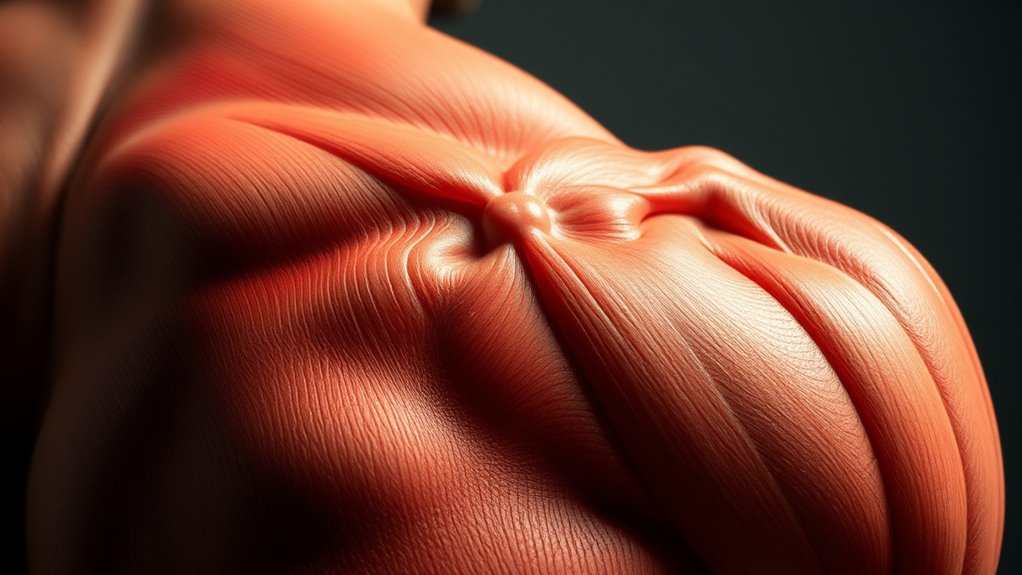Trigger points are small, tender knots within your muscles that can cause pain locally or in other areas. They form when muscle fibers contract and become hyperirritable, often from poor posture, overuse, or stress. These knots can feel tight or sensitive when pressed and may limit your movement. Recognizing these symptoms is the first step toward relief. If you want to learn how to identify and manage them effectively, keep exploring these helpful insights.
Key Takeaways
- Trigger points are small, hyperirritable spots within muscles that cause local or referred pain.
- They develop from muscle fiber contraction due to injury, poor posture, or repetitive strain.
- Trigger points often feel like tender, tight knots in the muscle tissue.
- Factors like stress, dehydration, and muscle overload contribute to their formation.
- Proper treatment includes manual therapy, stretching, and addressing underlying causes to relieve pain and prevent recurrence.

Ever wonder why certain muscles feel tight, tender, or cause pain even without an obvious injury? You might be dealing with trigger points—small, hyperirritable spots within your muscles that can produce discomfort locally or refer pain elsewhere. These knots are often misunderstood, but understanding their causes and treatment options can make a real difference.
Trigger points develop for various reasons. Poor posture, repetitive movements, stress, or muscle overload can cause tiny muscle fibers to contract and stay contracted, forming these tender spots. Sometimes, injuries or sustained muscle tension lead to inadequate blood flow, depriving muscle tissues of oxygen and nutrients. This creates a cycle where muscles become more prone to developing trigger points. Additionally, dehydration, nutritional deficiencies, or lack of physical activity can contribute to muscle weakness and increase vulnerability. Muscle physiology plays a key role in how trigger points form and persist.
Poor posture, injury, dehydration, and stress can all cause muscle knots to form and worsen.
The causes of trigger points are often intertwined with lifestyle factors. For example, if you sit at a desk for hours without proper ergonomic support, certain muscles like the neck, shoulders, or lower back may become overstressed. Overuse or repetitive motions, common in sports or manual labor, can also lead to muscle fatigue and trigger point formation. Furthermore, emotional stress can cause muscle tension, which may result in the development of these painful knots.
When it comes to treatment options, there’s no one-size-fits-all approach, but some strategies have proven effective. One common method is manual therapy, such as massage or trigger point release, which involves applying pressure to the knots to help break them down. Dry needling and acupuncture are also popular, targeting the trigger points directly to relieve pain and improve blood flow. Stretching and strengthening exercises can help prevent further trigger point formation by improving muscle flexibility and resilience. Physical therapy might incorporate ultrasound or electrical stimulation to reduce muscle tension. Managing stress through relaxation techniques or improving posture can also be essential in addressing the root causes. Recognizing these underlying factors can enhance treatment success and prevent recurrence.
Ultimately, understanding the causes of trigger points can empower you to seek appropriate treatment options and make lifestyle adjustments. Whether it’s through professional therapy or self-care routines, addressing these knots can alleviate pain, restore muscle function, and prevent future discomfort. Recognizing the signs early and taking action can keep your muscles healthier and more comfortable in the long run.
Frequently Asked Questions
Can Trigger Points Cause Headaches or Other Referred Pain?
Yes, trigger points can cause headaches and other referred pain. When these muscle knots develop, they often send pain signals to nearby or even distant areas, making it tricky to identify the actual headache causes. You might feel a headache originating from your neck or shoulders, which is a common symptom of trigger points. Recognizing these can help you target effective treatments for relief and better manage your pain.
Are Trigger Points Common in Athletes or Sedentary Individuals?
You’ll find trigger points pop up in both athletes and sedentary folks, like stubborn traffic jams in your muscle traffic. Athletes often develop these knots from intense workouts, causing muscle stiffness and postural imbalance, while sedentary lifestyles invite them through prolonged sitting and lack of movement. Both groups suffer from these hidden tension spots, making regular stretching and movement essential to keep your muscles smooth and pain-free.
How Long Does It Typically Take to Treat Trigger Points?
Treatment duration for trigger points varies, but you can often see improvements within a few sessions. The key is consistent therapy, like massage, dry needling, or stretching, which boosts therapy effectiveness. Some knots may resolve quickly, while others need ongoing care. Depending on the severity, full relief might take several weeks, but with regular treatment and proper self-care, you’ll likely notice reduced pain and increased muscle flexibility.
Can Trigger Points Develop Without Current Muscle Injury?
Like a silent storm brewing beneath calm waters, trigger points can develop without a recent injury. You might notice muscle knots forming due to chronic tension, repetitive strain, or stress, even if nothing specific caused them. These hidden culprits can persist silently, making your muscles feel tight and tender. Recognizing that trigger points don’t always need an injury helps you address chronic tension early, preventing pain from worsening over time.
Are There Specific Exercises to Prevent Trigger Point Formation?
Yes, you can prevent trigger point formation with regular stretching routines and strengthening exercises. Stretching helps loosen tight muscles, reducing strain that leads to knots, while strengthening exercises improve muscle stability and endurance. Incorporate these routines into your daily schedule, focusing on areas prone to tension. Consistency is key—by actively caring for your muscles, you lower your chances of developing trigger points and maintain overall muscle health.
Conclusion
Understanding trigger points can help you manage muscle pain more effectively. Did you know that up to 85% of chronic pain cases are linked to muscle knots? Recognizing these knots allows you to target relief strategies like massage or stretching. Taking action now can prevent discomfort from worsening over time. By staying aware of your muscle health, you’re better equipped to keep pain at bay and maintain your overall well-being.









